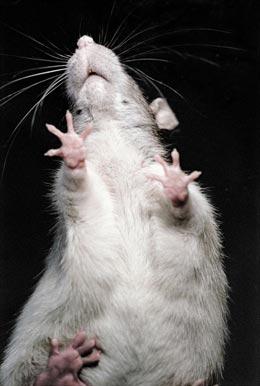Genetically engineered rats should follow soon, providing new models of human disease.
 Genetically engineered rats: coming to a lab near you.Alamy
Genetically engineered rats: coming to a lab near you.AlamyRat pluripotent stem cells - the essential ingredient for making genetically engineered versions of the animals - have finally been created after decades of effort in the field.
Scientists have long been able to alter the DNA in mouse embryonic stem cells, routinely creating mice with missing, added or altered genes. But the same techniques have not worked in rats, whose larger size can make them better models for certain disorders in humans. Although some techniques do exist for genetically manipulating rats, they are far more limited than those used in mice.
Twenty-seven years ago, researchers thought that genetically engineered rats would follow quickly after the development of the technique in mice. "We and others worked very, very hard [on rats] and got nowhere," recalls Martin Evans of Cardiff University, who won the 2007 Nobel Prize in Physiology or Medicine with Mario Capecchi and Oliver Smithies for work that made 'knockout' (loss of function) and 'knockin' (gene replacement or addition) mice possible.
Researchers led by Austin Smith of the University of Cambridge, UK, and Qi-Long Ying of the University of Southern California, Los Angeles, now report in Cell that they have derived rat embryonic stem (ES) cells that can transfer their genome into the sex cells of a growing rat1,2. Smith's team has also shown that the rat ES cells can be genetically manipulated. Neither has produced a genetically engineered rat yet. But Stem Cell Sciences, a company Smith co-founded, is already in discussions with pharmaceutical companies and animal providers to create and distribute knockout rats, says the company's chief executive Alastair Riddell. Ying says that the first genetically engineered rat from ES cells could be born within as little as six months.
Rat switch
Both Evans and Capecchi agree that moving from rat embryonic stem cells to genetically engineered rats should be swift and straightforward. However, they think mice have now become so well studied and well established that knockout rats may be less appealing. "Does this mean that everyone will switch to rats? I doubt it," says Capecchi, explaining that the cost of keeping laboratory rats is about ten times as great as for mice.
But some researchers are eager to apply the development in their own work. "Having access to genetically engineered rats would allow us to design more sophisticated experiments," says Viviane Tabar, a scientist and neurosurgeon at the Memorial Sloan-Kettering Cancer Center in New York City. "I definitely would use such rats in some of my experiments." Mouse spinal cords and other organs are so small that they make cell-transplant studies very difficult, she says. Moreover, rats are capable of more complex behaviour, making them better suited for studying some brain diseases.
Stem Cell Sciences has patent claims covering both the conditions used to derive the cells, as well as rat pluripotent stem cells themselves, says George Schlich, the company's intellectual-property lawyer. However, it is uncertain whether the company could control scientists' use of the technique.
And a complementary technique for making rat stem cells has recently been developed. Earlier this month, researchers led by Sheng Ding of the Scripps Research Institute in La Jolla, California, Hongkui Deng of Peking University and Lei Xiao of the Shanghai Institutes for Biological Sciences, created induced pluripotent stem (iPS) cells from cultured rat cells3,4. Along with genetic-engineering techniques like those used to create mouse and human iPS cells, culture conditions used by Deng and Ding were similar to those reported by Ying and Smith. Though these iPS cells have not yet been used to produce sex cells, the availability of both rat ES and iPS cells should enable a greater variety of experiments to be devised to compare the potential of the two cell types.
Culture club
Smith and Ying made their breakthrough by adapting the way ES cells are cultured. Mouse ES cells are generally grown in cultures containing proteins and cell extracts that prevent the cells from differentiating too quickly, conditions that proved unsuitable for rat ES cells. But while working as a postdoc in Smith's lab, Ying identified combinations of small molecules that allow mouse ES cells to grow stably, without the proteins and cell extracts. Both Smith and Ying applied these culture conditions to making rat ES cells after Ying established his own lab.
Ying thinks that these small molecules could allow ES cells to be derived in species beyond mice and rats. He is currently working with collaborators at the Second Military Medical University in Shanghai, China, to generate ES cells from large animals such as cows and pigs. Besides helping to create genetically engineered livestock, ES cells for large animals could help scientists study potential stem-cell therapies in species closer in size to the human patients who might receive them.
Ying says the next key step is to optimize the enzymes and reagents used to manipulate mouse ES cells so that they work better in rat cells. The researchers are also trying to identify the best rat strains to use for generating ES cells and host embryos, as well as to identify better culture conditions.



No comments:
Post a Comment